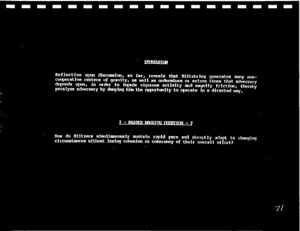Patterns of Conflict
| The works of |
| Works of John Boyd |
|---|
OODA WIKI Edition
Quantico Transcription
Here’s the impression I’m trying to leave you with. If you look at that, here’s the impression. Look what happened to you. If you think about that, what are they doing? Generates many non-cooperative center of gravity, because all these thrusts are going in there, and they’re dividing not only physical, but mental and moral. They’re working on that organism at all levels.
And so what does that do then? Well, it undermines them. Not only that, it undermines and seizes the important things that the adversary depends upon. Remember we talked about those vulnerabilities. Colonel, remember we talked about those?
You go through those weaknesses. Now you’ve undermined and seized those things that he really depends upon, his critical vulnerabilities, as you're working your way through his system.
But you had to expose it before you could do that. Expose that vulnerability. Go ahead.
Audience: I can see where you get your non-cooperative centers of gravity in guerrilla war. Can you inform me how you get that from blitzkrieg, I missed that.
Boyd: Well, I sort of haven't. I cheated a little bit, not too much. We’ve got to go back to Guderian and, hang on [transparencies shuffling]. Multiple thrusts. Remember I said multiple thrusts? Guderian’s multiple thrusts— I’ll go into more detail later on. But I had it in that one
chart. I didn’t say it here.
Audience: Basically you were talking about the tactical centers of gravity vice—
Boyd: Yeah, but they do it at all levels. They do it tactical, grand tactical. I’m going to show you that later on.
Audience: What I’m saying is, they’re not tying into the social fibers like the guerrillas do.
Boyd: But they’re not getting into the social fibers like the guerrillas do. That’s correct.
Remember I said, remember they’re not getting into that moral dimension like the guerrillas are. We’ll get into that later on. I can’t put it all in one chart. You’ve got to let me sequence it a little
bit. But you’re going to see, I’m going to bring it in. You have a good question. Just hang onto it.
But you’re right. The point that they’re not getting at that moral fiber like the guerrillas do.
That’s correct. There’s a difference, and we’re going to bring that out. I just can’t do it all in one chart. I’ve got to bring out the first bit first. Okay.
But raises a nagging question then. How do they simultaneously sustain a rapid pace and abruptly adapt to changing circumstances? In other words, you’re trying to go fast-forward and it’s— if you adapt, it’s hard to go fast-forward. If you go fast-forward, then it’s hard to adapt. So
in other words, they look like two things that don’t go together very well.
Not only that, if you try to exercise two commands from the top, it becomes rigid. Yet you’ve let the guy do their thing. Then you can’t hold the whole thing together. Two more opposing things here. Christ, we let them do what they want, the whole goddamn thing’s going to fly apart, the operation. [05:00] On the other hand, if we impose too much control from the top, goddamn, you’re slow as molasses in January.
So you have the opposing tendencies here. So the question is how you resolve these opposing tendencies. Here’s one, rapid pace versus local adaptation. You get them adapting over, they’re not going rapid pace into the rear. And the other thing is, you oppose too much top down command and control, you may have good control. But now you have a rigid thing that can’t adapt. On the other hand, if you give them freedom, the whole thing flies apart and you’re not realizing your purpose.
It’s there, so you say we’ve got to resolve that. We can’t resolve that, we got a big problem here. So let’s look into that.
